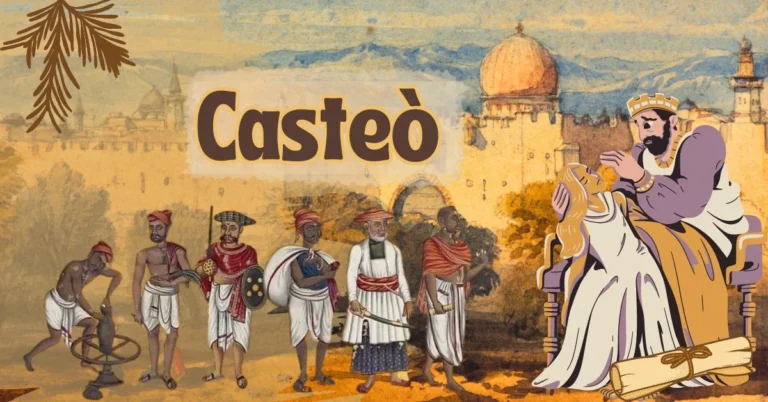Introduction
Casteò, a system of social stratification that has existed for centuries, continues to shape societies in various parts of the world. While its origins are complex and multifaceted, Casteò remains a significant aspect of many cultures, influencing social interactions, economic opportunities, and political dynamics. In this article, we will explore the concept of Casteò, its historical roots, its manifestations in different societies, and its impact on individuals and communities.
Origins of Casteò: Historical Perspective
The origins of the Casteò system are deeply rooted in ancient Indian society, where it was initially conceived as a system of occupational divisions based on hereditary factors. The Rigveda, one of the oldest sacred texts of Hinduism, contains references to varna, the four main social classes: Brahmins (priests and scholars), Kshatriyas (warriors and rulers), Vaishyas (traders and merchants), and Shudras (laborers and service providers). Over time, these broad categories evolved into a complex system of thousands of sub-Casteò’s, known as jatis, each with its own customs, traditions, and social status.
Manifestations of Casteò Across Cultures
While the Casteò system originated in India, similar systems of social stratification exist in other parts of the world. In Japan, for example, the Burakumin historically occupied the lowest rung of the social hierarchy, performing jobs considered impure or undesirable by mainstream society. In Nigeria, the Osu Casteò system among the Igbo people segregates individuals into “freeborn” and “descendants of slaves,” with the latter facing discrimination and exclusion from certain social activities. These examples illustrate the diverse ways in which Casteò-like systems have manifested across different cultures and historical contexts.
Social Implications of Casteò
Casteò profoundly influences social interactions and relationships, often determining whom one can marry, associate with, or even share meals with. In many societies, inter-Casteò marriages are frowned upon or outright forbidden, perpetuating the boundaries between different Casteò groups. Discrimination and prejudice based on Casteò remain pervasive, leading to unequal access to education, employment, and healthcare for members of marginalized Casteò’s. Despite legal efforts to eradicate Casteò-based discrimination, social attitudes and cultural norms continue to perpetuate these inequalities.
Economic Dimensions of Casteò
Casteò also plays a significant role in shaping economic opportunities and outcomes. Historically, certain Casteò’s were relegated to occupations deemed ritually impure or menial, such as manual scavenging or leatherwork, while others enjoyed privileged access to education and high-status professions. Although economic liberalization and modernization have led to some changes in occupational patterns, Casteò-based disparities persist in areas such as land ownership, income levels, and access to credit and entrepreneurial opportunities. Moreover, Casteò-based networks and affiliations often determine access to jobs and business contracts, reinforcing existing inequalities.
Political Dynamics and Casteò
Casteò has long been intertwined with politics in many societies, influencing electoral outcomes, party affiliations, and governance structures. In India, for instance, Casteò-based political parties and interest groups mobilize voters along Casteò lines, promising to advance the interests of specific Casteò constituencies. Reservation policies, which allocate seats in educational institutions and government jobs for members of marginalized Casteò’s, are a contentious issue in Indian politics, with proponents arguing for social justice and detractors criticizing them as perpetuating Casteò-based divisions. Similar dynamics can be observed in other countries where Casteò plays a prominent role in politics and governance.
Challenges and Prospects for Change
While efforts to address Casteò-based discrimination and inequality have made some progress, significant challenges remain. Deeply ingrained social attitudes and cultural practices reinforce Casteò-based hierarchies, making meaningful change difficult to achieve. Moreover, economic globalization and urbanization have brought new complexities to the Casteò equation, with traditional social structures interacting with modern forces of capitalism and consumerism. Nevertheless, grassroots movements, legal interventions, and advocacy efforts continue to push for greater equality and social justice, raising awareness about the pernicious effects of Casteò-based discrimination and advocating for policies that promote inclusivity and equal opportunity.
Conclusion
Casteò is a complex and multifaceted social phenomenon that continues to shape societies and individual lives in profound ways. Rooted in ancient traditions yet evolving in response to changing social, economic, and political dynamics, Casteò remains a potent force in many cultures around the world. While efforts to address Casteò-based discrimination and inequality face numerous challenges, the quest for social justice and equality remains a vital and ongoing struggle. By understanding the origins, manifestations, and implications of Casteò, societies can work towards creating a more inclusive and equitable future for all.

